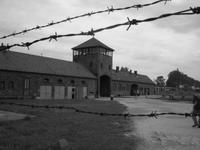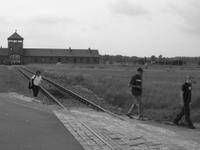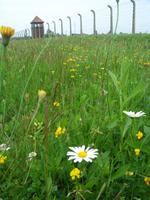We boarded the train at 11 am and then arrived in Oswecim (the Polish name for Auschwitz) about 8 pm. We had a neat train compartment that conjured up images of European train travel, and had a neat European train delay for about an hour. A young Czech man traveling in our compartment was headed to his hometown Ostrava, and told us this almost never happened with Czech trains, but the one ahead of ours was delayed as well. I figured it was a good time to go back to that classic in Czech literature, Hrabal’s Closely Watched Trains. I missed the drug-sniffing Polish dogs because I was fighting sleep while listening to Goenkaji’s chanting on my walkman, but later opened my eyes to see an entirely different countryside passing before us. It was more industrial and somehow something about it looked poorer as well. At our transfer in Katowice, we found out that Poland had their version of the heselbaba as well, and not having any Polish slotzy or even grotzy I was turned away with a pleasant shrug of the shoulders (we were quite pleased by the Polish service industry, as it turned out). So I ventured outside and used the facilities at KFC, in a state of awe at how different this place across the border was. People, their clothes, the buildings and streets, and just overall energy made it clear that this was a totally different culture. We found our hotel, named the HOTEL GLOB with the image of a globe beside it, just a few steps from the train station, and ventured to the nearby Restaurant Skorpian to seek out veggie cuisine yet again.
The next day we walked along the street to go to the first of three Auschwitz camps. My mom and I had spent our second day in Prague visiting the nearby Terezin concentration camp, and that did much to prepare me for this. In some ways it was more terrifying, because entire parts of

the camp remain as they must have been 60 years ago, and there are far less tourists around to distract from the horror. The tourists at Auschwitz—especially this first camp— were beyond anything I could have ever imagined. There were entire buildings you couldn’t even enter because of the sheer amount of people inside, speaking every language you could think of and even some you couldn’t. We walked past the old railway tracks that brought so many millions to their deaths, and under the Arbeit Makt Frei (Work Makes Free) arch-post. Many of the barracks had been turned into exhibitions that showed different aspects of the Holocaust—entire buildings devoted to the Jews of a single country: France, Italy, Czech, Slovakia, Belgium, Holland, Poland, etc. Others talked about different aspects of the camp itself. There was one small courtyard that was infamous for the tens of thousands of people killed by firing squads. After lunch, we took a bus to the nearby second camp, which is 25 times larger. This was instantly identifiable by the main set of train tracks running under the guard tower that we have all seen from so many WWII photos. There were a couple dozen very large barrack buildings still standing, and a literally uncountable number of others that had collapsed and left only the brick chimneys in their wake. At the end of the camp were the destructed gas chambers and crematorium. It was a sickening and wordless thing to take in these Nazi ruins, and the sheer amount of industry and heavy metal that had gone into creating them. To see that twisted iron, broken and warped cement, and the moss growing upon it and bugs crawling through the moss… what can be said?

We took a sobering walk from one end to the other, crisscrossing length and width, and several thoughts came to me. The first was my surprise at how lush and green this area was. I never would have expected it—I’d have thought it would all be an industrial wasteland. Trees were actually planted and spaced out, and the surrounding areas were beautiful forest. Taking a photo in color and then the same shot in black and white was almost an unbelievable difference. I also was surprised how much these camps resembled something like a photo negative from a meditation course— everything is turned around almost perfectly 180 degrees, even though the bare image has a similarity. The solitude in the meditation courses is fostered in an atmosphere of the serving staff providing an environment of loving-kindness that permeates into the very food and ground you walk on, and the entire operation is based on the idea of helping others to come out of their misery. Here in Poland, the only motivation was to create suffering, and the rules existed only to terrorize the prisoners. The whole place was filled with a deep pain that permeated everything. I was amazed at the amount of work, energy, time, commitment, thought, and planning that went into something so evil. It wasn’t like a very cruel action that just blinds one in a moment and they don’t know what they’re doing. It was a coordinated series of steps that involved work from doctors, food service people, architects, engineers, to say nothing of the guards themselves. How such a madness can sweep over so many people for such a period of time was baffling to me. Remembering this, I tried to have compassion not only for the suffering the prisoners went through, but also for the madness of this evil and inhumanity that the guards themselves must have suffered from.
I had been hesitant to coming here, since I knew these vibrations of cruelty and death were developed over several years, and must surely still inhabit the area, and it wasn’t appealing to put myself in such an environment. But once there, I realized one of the predominant

vibrations I felt was that of modernity, and I thought it must be the rather superficial one of all these tourists now coming. This was a kind of welcome distraction for me to not have to be aware the depth this place must carry. There were only two times I was alone, and they were both terrifying. The first, I made myself walk through a deserted barrack that I couldn’t get out fast enough, and I had to fight a very loud irrational thought in my mind that if I didn’t get out soon enough I’d find myself in 1942. The second time, I meditated for a half hour in the hotel room after my family left to wait for the train, and I could feel the fear again, getting stronger so that I eventually had to turn to the chanting tape from Goenkaji. I can’t imagine living in this town, now or then, and I was happy when I finally could get out of Dodge a few minutes later.
We left in the morning and spent the next day in Krakow, which is just a beautiful city. We walked through the old town, past a large walled castle, and through the fascinating streets of the Jewish Quarter. At one museum a young man estimated there were about 200 Jews in Krakow today, and a couple thousand in the entire country. Enjoying our last few sips of the wonderful Polish gazawana, we spent our remaining change and boarded the night train back to Prague at 11 pm. I had six to seven solid hours of train sleep, minus a few minutes of being woken in the early morning hours at the border crossing, and we arrived in Prague at 7 am.
No comments:
Post a Comment